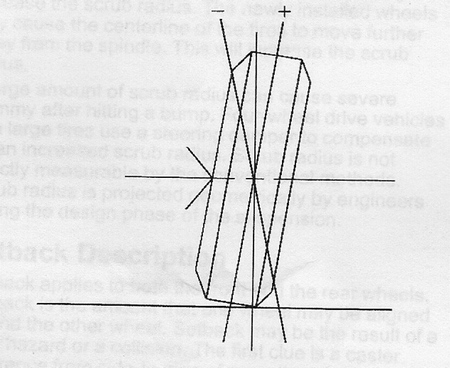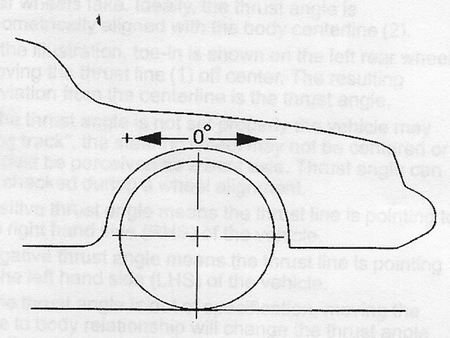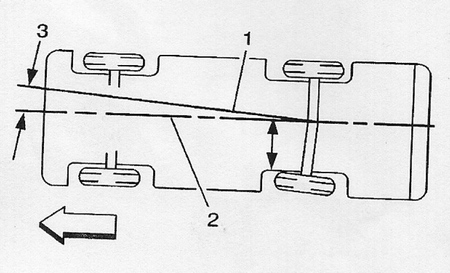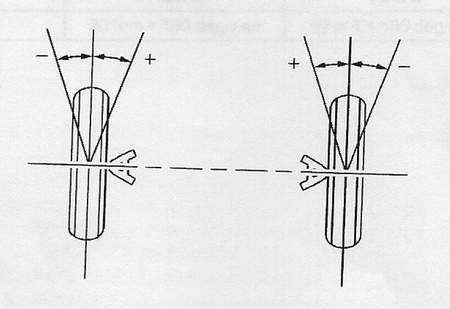Tech Article: Suspension Alignment Settings Explained
Camber:

Camber is the tilting of the wheels from the vertical when viewed from the front of the vehicle. When the wheels tilt outward at the top, the caster is positive (+). When the wheels tilt inward at the top, the camber is negative (-). The amount of tilt is measured in degrees from the vertical. Camber settings influence the directional control and the tire wear.
Too much positive camber will result in premature wear on the outside of the tire and cause excessive wear on the suspension parts. Too much negative camber will result in premature wear on the inside of the tire and cause excessive wear on the suspension parts.
Unequal side-to-side camber of 1 degree or more will cause the vehicle to pull or lead to the side with the most positive camber.
Caster:

Caster is the tilting of the uppermost point of the steering axis either forward or backward, when viewed from the side of the vehicle. A backward tilt is positive (+) and a forward tilt is negative (-). Caster influences directional control of the steering but does not affect the tire wear. Caster is affected by the vehicle height, therefore it is important to keep the body at its designed height, or correct the caster setting when altering the vehicle's height. Overloading a vehicle or a weak or sagging rear spring will affect caster. When the rear of the vehicle is lower than it's factory ride height, the front suspension moves to a more positive caster. If the rear of the vehicle is higher than it's factory ride height, the front suspension moves to a less positive caster.
With too little positive caster, steering may be touchy at high speed and wheel returnability may be diminished when coming out of a turn. If one wheel has more positive caster than the other, that wheel will pull toward the center of the vehicle. This condition will cause the vehicle to pull or lead to the side with the least amount of positive caster.
Lead / Pull:
At a constant highway speed on a typical straight road, lead/pull is the amount of effort required at the steering wheel to maintain the vehicle's straight path. Vehicles will tend to lead/pull in the direction of the road slope as part of normal operation. Lead/pull is usually caused by the following factors:
- Road slope
- Variability in tire construction
- Wheel alignment (front cross caster and camber)
- Unbalanced steering gear
- Electronic Power Steering (EPS) steering position and torque sensors not calibrated correctly, if equipped.
Memory Steer:
Memory steer is when the vehicle wants to lead or pull in the direction the driver previously turned the vehicle. Additionally, after turning in the opposite direction, the vehicle will want to lead or pull in that direction.
Ideally, the scrub radius is as small as possible. Noramlly the SAI angle and the centerline of the tire and the wheel intersect below the road surface, causing a positive (+) scrub radius. With struts, the SAI angle is much larger than the long arm/short arm type of front suspension. This allows the SAI angle to intersect the camber angle above the road surface, forming a negative (-) scrub radius. The smaller the scrub radius, the better the directional stability. Installing aftermarket wheels that have additional offset will dramatically increase the scrub radius. The newly installed wheels may cause the centerline of the tires to move further away from the spindle. This will increase the scrub radius.
A large amount of scrub radius can cause severe shimmy after hitting a bump. Four wheel drive vehicles with large tires use a steering damper to compensate for an increased scrub radius. Scrub radius is not directly measurable by the conventional methods. Scrub radius is projected geometrically by engineers during the design phase of the vehicle's suspension system.
Setback:
Setback applies to both the front and rear wheels. Setback is the amount that one wheel may be aligned behind the other wheel. Setback may be the result of a road hazard or a collision. The first clue is a caster difference from side-to-side of more than 1 degree.
Thrust Angles:

The front wheels aim or steer the vehicle. The rear wheels control tracking. This tracking action relates to the thrust angle. The thrust angle is the path that the rear wheels take. Ideally, the thrust angle is geometrically aligned with the body centerline.
In the above illustration, toe-in is shown on the left rear wheel, moving the thrust line off center. The resulting deviation from the centerline is the thrust angle.
If the thrust angle is not set properly the vehicle may "dog track", the steering wheel may not be centered or it could be perceived as a bent axle. Thrust angle can be checked during a wheel alignment.
Positive thrust angle means the thrust line is pointing to the right hand side of the vehicle. Negative thrust angle means the thrust line is pointing to the left hand side of the vehicle.
If the thrust angle is out of specification, moving the axle to body relationship will change the thrust angle reading. If the vehicle is out in the positive (+) direction, moving the right hand side forward and/or the left hand side rearward will move the thrust angle towards 0 degrees. If the vehicle is out in the negative (-) direction, moving the right hand side rearward and/or the left hand side forward will move the thrust angle towards zero degrees.
Toe:

Toe is a measurement of how much the front and/or rear wheels are turned in or out from a straight-ahead position. When the wheels are turned in, toe is positive (+). When the wheels are turned out, toe is negative (-). The actual amount of toe is normally only a fraction of a degree. The purpose of toe is to ensure that the wheels roll parallel.
Sample Front End Alignment Specifications:
2010 Chevrolet Camaro SS
Camber: -0.8* (+/- 0.75*)
Cross Camber: (L-R): 0.00* (+/- 0.75*)
Caster: 6.6* (+/- 0.75*)
Cross Caster: 0.00* (+/- 0.75*)
Total Toe: +0.20* (+/- 0.20*)
Steering Wheel Angle: 0.00* (+/- 3.50*)

 The article has been updated successfully.
The article has been updated successfully.




